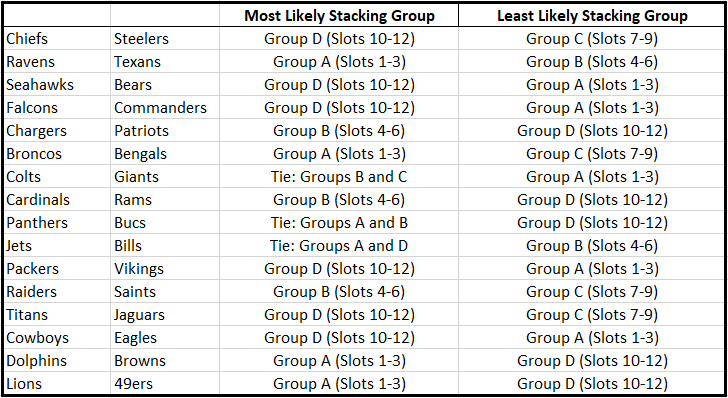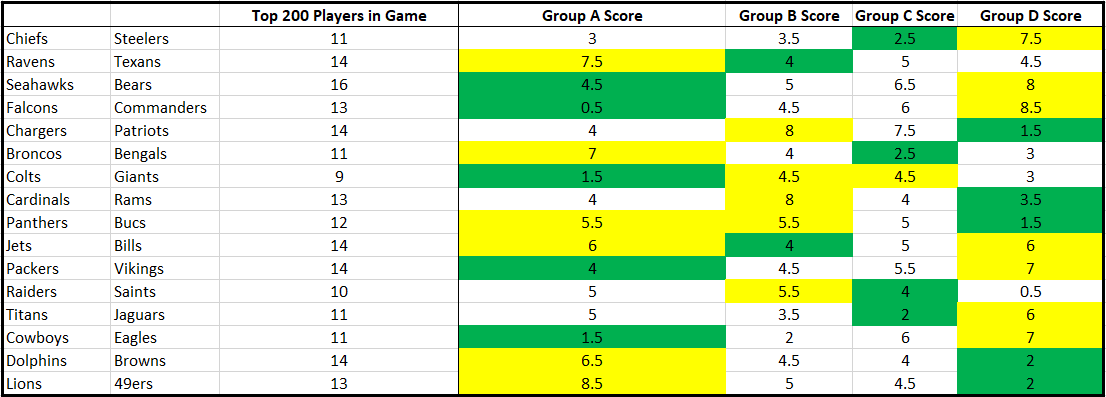USING ADP TO PREDICT WHICH DRAFT SLOTS ARE MORE LIKELY TO STACK WHICH GAMES
Recently, I wrote about the concept of building unique roster spots by drafting players likely to be selected in a low percentage of drafts. You can read the full article here, but the general take-away was that players selected in fewer than 10% of Best Ball Mania IV (BBMIV) drafts ultimately did not work out as planned. Of 32 players who were drafted in fewer than 10% of drafts but who were on rosters advancing to the BBMIV finals, only Trey Palmer turned in a serviceable Week 17 performance, finishing as WR19 on the week with 14.4 half PPR points.
However, the article also noted the option of building unique rosters not through late round dart throws, but rather through making atypical selections throughout the draft by going against the ADP grain. It’s always worth mentioning that this strategy carries risk – it’s rarely a good strategy to intentionally reach on worse players to achieve a unique roster. You’re far more likely to put together a team that doesn’t advance to begin with, thus rendering your unique roster essentially worthless.
But there is still more to dig into here. As the 2024 NFL schedule has now been released, we can now examine which draft slots have the most efficient access to specific Week 17 games by ADP. For example, pretend that you join a draft and get Pick 7. It can be very useful to know which game stacks other players are more likely to build out of the Pick 7 slot, assuming that ADP is at least loosely followed. There is always a lot of discussion on which games to stack, and they often come with a caveat along the lines of “the Kyler/McBride stack is on the other end of the board." I wanted to figure out which stacks align most nicely to current ADPs so that there is a handy reference guide to always know which stacks are less likely to be built by other players drafting from the same position.
So how was this exercise done?
First, I took BBMV ADP data from here, and selected the date range filter of May 13-May 20. For this article, I am only using players with a Top 200 ADP.
I created 4 groups of Draft Pick Slots:
· Group A – Picks 1-3
· Group B – Picks 4-6
· Group C – Picks 7-9
· Group D – Picks 10-12
By grouping these pick slots together, it allows for more wiggle room in terms of reaching on a player by only a spot or 2. It also helps keep the data more manageable.
From there, it was all very simple. I correlated which draft pick slot Groups selected the most (and fewest) players from each respective Week 17 game.
For example, Drake London, Kyle Pitts, and Jahan Dotson all have current ADPs that align directly with the draft picks owned by Group D (pick slots 9-12). If your randomized draft slot is not in this group, it is very unlikely that you would be able to stack these 3 players together without significant ADP reaches. This logic was expanded to all players currently being drafted in the Top 200.
I assigned each game a Group Score based on:
a) The number of players currently being selected correlating Group positions
b) A slightly staggered variation of groupings to account for slight (i.e. 5-6 pick reaches). This isn’t 100% perfect, but does account for reasonable draft picks being made to complete a stack. This staggered data is weighted less than the exact correlation data.
Findings
Below is a different presentation of the data. This is best used if you’re on the clock and need a quick look at which game stacks are most or least likely based on where you’re drafting from. A reminder: the terms “Common” and “Unique” are used for clarity. These stacks will not necessarily be the ones most commonly built by these draft groups, but they are the likely (and least likely) stacks to be built, based on ADP:
Now, here are all of the exact numbers:
Conclusions
It must be stated once more: it’s probably not a good idea to build rosters by reaching. It’s definitely not a good idea to go into a draft predetermined to stack a certain game or team. But if the right combination of players falls, or if you have strong convictions that a team is being misevaluated by the market, putting together a game stack that is relatively unique based on your draft slot could be a good strategy.
It’s also worth noting that in order to benefit from this, you have to basically draft your non-game stack players at ADP. If you go out of your way to put together a unique game stack and then also reach on other players that are not part of the stack, you aren’t being unique: you’re basically mimicking another draft slot’s more likely roster outcomes.
Also, these numbers are obviously subject to change. While the date range takes into account mostly drafts that have been done post schedule release, fluctuations in ADP will change the exact numbers above even if the formula remains sound. The results in this article can obviously change due to ADP changes based on fluctuating depth charts, but also due to players chasing specific stacks, especially as the summer moves forward. There will be a lot of drafters desperate to put together specific game stacks to ensure certain levels of exposure, and that could change the results above, especially for the drafting groups at each turn.


